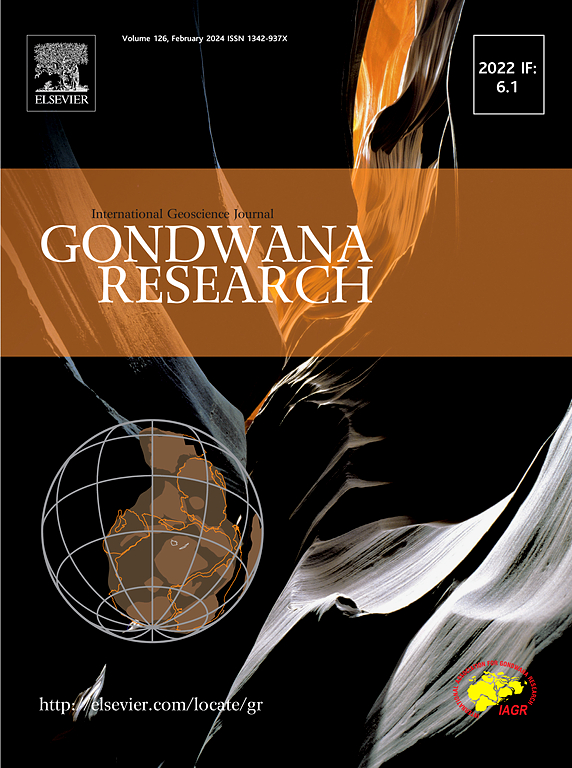Integrated analyses of the Ediacaran-Cambrian boundary sequence in northern Gondwana (Anti-Atlas platform, Morocco)
IF 7.2
1区 地球科学
Q1 GEOSCIENCES, MULTIDISCIPLINARY
引用次数: 0
Abstract
The Ediacaran to Cambrian transition (ECT) represents a critical period in Earth’s history, marked by the rapid emergence and diversification of metazoan life. Understanding the precise timing and dynamics of this bio-event as well as their links to paleoenvironmental changes requires a well-defined stratigraphic framework. The Anti-Atlas platform in Morocco offers a key region for unravelling the tectono-sedimentary setting, chemostratigraphic and geochemical features of ECT in northern Gondwana margin. Stratigraphic record of this transitional interval lying in the Lower Adoudou Formation (Tabia-Tifnount Members transition) is well-constrained by δ13Ccarb chemostratigraphy and geochronology. However, the basin evolution analysis based on sequence stratigraphy has received little attention, as well the exact location of the Ediacaran-Cambrian boundary in this region remains uncertain, partly due to the absence of typical small shelly fossils and trace fossil assemblages. In this study, we apply an integrated approach combining sedimentary, stratigraphic, paleontological, and geochemical analyses to investigate the Tabia section, one of the most continuous ECT sequences in northern Gondwana. The stratigraphic record reveals four key stages in the tectono-sedimentary evolution. The synrift stage comprises three tectonic pulses, each corresponding to distinct depositional sequences within the Tabia Member. The progressive extension starts with rift initiation forming a narrow rift branch and culminates during rift propagation with wide rift branch during the following two tectonic pulses. The postrift stage coincides with a shift to the stable carbonate platform of Tifnout Member. This geodynamic and paleogeographic transition is well documented by geochemical evidence. In contrast to the postrift strata, synrift sequences preserve increased syn-sedimentary fault-driven hydrothermal activity and related dolomitization process (e.g., higher 87Sr/86Sr ratios, Eu/Eu* anomalies, and elevated concentrations of metals). In addition, our results offer new fossils and δ13Ccarb chemostratigraphy constraints on the precise placement of the Ediacaran-Cambrian boundary across the platform, suggesting that the synrift Tabia Member and postrift lower part of Tifnout member including Tamjout dolomite are late Ediacaran in age. The first negative excursion in the Lower Tifnout Member is interpreted as the basal Cambrian carbon isotope excursion (BACE), coinciding with the transition from synrift to post-rift settings in the western Anti-Atlas platform.

摩洛哥冈瓦纳北部(Anti-Atlas台地)埃迪卡拉-寒武系界线层序综合分析
埃迪卡拉纪到寒武纪的过渡(ECT)是地球历史上的一个关键时期,以后生动物的迅速出现和多样化为标志。要了解这一生物事件的确切时间和动力学,以及它们与古环境变化的联系,需要一个明确的地层框架。摩洛哥Anti-Atlas台地为揭示冈瓦纳北部构造沉积背景、化学地层和地球化学特征提供了关键区域。该过渡段位于下阿斗斗组(tabia - tifont段过渡),其地层记录受到δ13Ccarb化学地层学和地质年代学的约束。然而,基于层序地层学的盆地演化分析很少受到重视,而且由于缺乏典型的小壳类化石和微量化石组合,该区埃迪卡拉-寒武系界线的确切位置仍不确定。本文采用沉积、地层学、古生物学和地球化学分析相结合的综合方法,对冈瓦纳北部最连续的ECT层序之一Tabia剖面进行了研究。地层记录揭示了构造-沉积演化的四个关键阶段。共融期包括三个构造脉冲,每个构造脉冲对应于塔巴尼亚段不同的沉积层序。在随后的两个构造脉冲中,以裂谷起始形成窄裂谷分支为开始,以裂谷扩展形成宽裂谷分支为结束。后期与蒂夫特段稳定的碳酸盐岩台地相吻合。地球化学证据充分证明了这一地球动力学和古地理转变。与裂谷后地层相比,同沉积断层驱动的热液活动和相关的白云化过程(例如,较高的87Sr/86Sr比值、Eu/Eu*异常和金属浓度升高)保持在同一沉积层序中。此外,我们的研究结果为埃迪卡拉-寒武系界线的精确定位提供了新的化石和δ13Ccarb化学地层学约束,表明叠裂带Tabia段和叠裂带后下部包括Tamjout白云岩属于晚埃迪卡拉纪。下蒂夫特段的第一次负偏移被解释为基底寒武纪碳同位素偏移(BACE),与反阿特拉斯地台西部从syn裂谷到后裂谷环境的转变相吻合。
本文章由计算机程序翻译,如有差异,请以英文原文为准。
求助全文
约1分钟内获得全文
求助全文
来源期刊

Gondwana Research
地学-地球科学综合
CiteScore
12.90
自引率
6.60%
发文量
298
审稿时长
65 days
期刊介绍:
Gondwana Research (GR) is an International Journal aimed to promote high quality research publications on all topics related to solid Earth, particularly with reference to the origin and evolution of continents, continental assemblies and their resources. GR is an "all earth science" journal with no restrictions on geological time, terrane or theme and covers a wide spectrum of topics in geosciences such as geology, geomorphology, palaeontology, structure, petrology, geochemistry, stable isotopes, geochronology, economic geology, exploration geology, engineering geology, geophysics, and environmental geology among other themes, and provides an appropriate forum to integrate studies from different disciplines and different terrains. In addition to regular articles and thematic issues, the journal invites high profile state-of-the-art reviews on thrust area topics for its column, ''GR FOCUS''. Focus articles include short biographies and photographs of the authors. Short articles (within ten printed pages) for rapid publication reporting important discoveries or innovative models of global interest will be considered under the category ''GR LETTERS''.
 求助内容:
求助内容: 应助结果提醒方式:
应助结果提醒方式:


